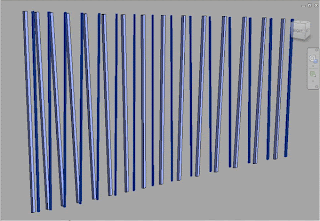Thanks to Dave Baldacchino for pointing out my blind spot. (see comments on previous post) My take on the Voysey style stair screen is much more easily achieved using a curtain wall & edit wall profile.
Which got me to thinking if there were any advantages to the adaptive component approach. What if you wanted to curve the screen. Not possible to edit profile on a curved wall.
But of course you could make an in-place mass & do a "curtain system by face". But now we are approaching a situation where it's almost as much effort as making an adaptive family. And once you have made the family it's easy to play with different parameter values. Design by flexing ... appropriate if you have a vague concept and want to explore the possibilities.
Once I got started on "S" curves I couldn't resist setting up an alternating pattern. Now we are entering territory where curtain walls struggle. I'm not going to do a step-by-step on this. It's an extension of the principles from the previous post, but with a bit of "host by intersection" thrown into the mix.
The possibilities are pretty much endless. Not sure what the application would be, starting to feel more like Calatrava than Voysey now. Also looks like some kind of drunken bar code.
It's difficult to grasp the geometry fully based on single frames. It could be a screen or a ceiling baffle in an up-market food court perhaps. I've seen crazier forms. The excitement would be in the changing patterns as you walk past.
Using a different colour and size for the two repeaters makes it easier to understand, which is why I did that. Then I realised that alternating mullion types would be another justification for the adaptive approach, even on a straight screen. You could do it with a curtain wall, but it starts to get messy, especially if you want to go through several design iterations.
I'm going to finish up with a little GIF to simulate the effect of movement. And thanks again to Dave for making me think harder about what I am doing and why I might want to do it in a certain way.
Which got me to thinking if there were any advantages to the adaptive component approach. What if you wanted to curve the screen. Not possible to edit profile on a curved wall.
But of course you could make an in-place mass & do a "curtain system by face". But now we are approaching a situation where it's almost as much effort as making an adaptive family. And once you have made the family it's easy to play with different parameter values. Design by flexing ... appropriate if you have a vague concept and want to explore the possibilities.
Once I got started on "S" curves I couldn't resist setting up an alternating pattern. Now we are entering territory where curtain walls struggle. I'm not going to do a step-by-step on this. It's an extension of the principles from the previous post, but with a bit of "host by intersection" thrown into the mix.
The possibilities are pretty much endless. Not sure what the application would be, starting to feel more like Calatrava than Voysey now. Also looks like some kind of drunken bar code.
It's difficult to grasp the geometry fully based on single frames. It could be a screen or a ceiling baffle in an up-market food court perhaps. I've seen crazier forms. The excitement would be in the changing patterns as you walk past.
Using a different colour and size for the two repeaters makes it easier to understand, which is why I did that. Then I realised that alternating mullion types would be another justification for the adaptive approach, even on a straight screen. You could do it with a curtain wall, but it starts to get messy, especially if you want to go through several design iterations.
I'm going to finish up with a little GIF to simulate the effect of movement. And thanks again to Dave for making me think harder about what I am doing and why I might want to do it in a certain way.








Hi Andy!!! Thanks for your virtuous post. This is probably something I need at the moment. Can you help in sorting a boulder repeating "wall"? I was thinking and playing around to make a component based family of a boulder "wall" to put it over a retaining landscape wall. Ideally I wanna have 2 dimensions length and height with a possibility to fit X number of boulder rows and Y number of Boulder columns ... or columns could depend on the length of the "wall"..I just need some guidance...Thanks!!!
ReplyDelete